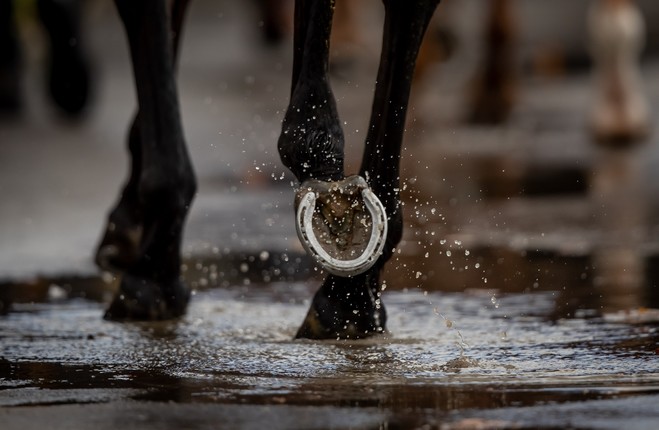LAST UPDATE | 20 Jan 2021
TO ASSUME, AS my old school principal used to impart, can make an ass of you and me.
It is no exaggeration to say that Irish horse racing was rocked to its core on Monday as the Irish Horseracing Regulatory Body announced that high-profile trainer Charles Byrnes had his licence suspended for six months and was fined €1,000 following an investigation into the running of one of his horses, Viking Hoard, in October 2018. Byrnes has already indicated that he will appeal the decision.
The race in question was a handicap hurdle in Tramore that should have been – and, up until now, was – entirely forgettable. One of the beauties of racing, oft-times a terrible beauty, is that the extraordinary will sprout from the banal.
To understand the circumstances surrounding what happened and what might have happened that day, you should talk to people within racing, read articles on the case – in particular the IHRB’s full details of same – and develop your own understanding of it all. And even that will only get you so far.
Why did it take so long for the IHRB to come to a decision? The key was the betting patterns and the tedious nature of that part of the investigation, while Covid-19 also exacerbated the delay. For racing, it was worth the wait.
To go over the case, Viking Hoard was pulled up in a handicap hurdle at Tramore on 18 October 2018. It was a performance on every level that was too bad to be true. A urine sample was found to contain hydroxyethylpromazinehydroxide (HEPS), a metabolite of acepromazine (ACP). ACP is a prohibited substance. HEPS was found in high enough concentration to exceed the International Screening Limit of 10 nanograms/millilitre: the estimated detected level was 1,000 nanograms per millilitre.
In other words, whoever gave the horse the sedative had administered it to levels so as to ensure he could barely make it to the start to race, not to mind win it.
The case was referred to a three-person committee, chaired by High Court judge Justice Tony Hunt, which heard evidence from the IHRB’s chief veterinary officer and head of anti-doping Dr Lynn Hillyer, IHRB deputy head of security Declan Buckley, Byrnes, and veterinary surgeon Vincent O’Connor. The IHRB did not allege that Byrnes was directly involved in either the administration of ACP, the banned substance, nor that he had any connection to the betting patterns being examined.
The committee viewed a recording of the race in which Viking Hoard ran “conspicuously badly” and received a reminder from his jockey immediately after jumping the first hurdle, according to the report. In its evidence, the IHRB explained that it had received alerts from the British Horseracing Authority relating to betting patterns on Viking Hoard. These were based on information received from betting exchanges, which allow their clients to ‘lay’ horses — to bet that the horse will lose, rather than win — something that many people within racing will never be able to condone.
The investigation of the exchange betting patterns also included two races in which Viking Hoard ran prior to Tramore, one at the Galway festival in July 2018 and another at Sedgefield in October of that year. Across those three races, Viking Hoard was laid for a total liability of €120,000 to win just over €27,000 on aggregate. The account which the IHRB traced those substantial bets back to belongs to “an individual who is based in a distant part of the world and was said to be associated with match-fixing and associated betting in connection with other sports”, although there is “no evidence to connect Byrnes with these betting patterns”.
So who administered the dose to the horse and why? It is accepted that it happened at Tramore. The IHRB said it approached the case on the interpretation of the evidence that was “reasonably open and most favourable to Mr Byrnes, that being that Viking Hoard was ‘nobbled’ by an unidentified third party at a time when the gelding was left unaccompanied”.
Less than a year previously, I was laughed at for suggesting that Willie Mullins’ superstar Faugheen could have been got at before a Leopardstown race in which he inexplicably failed to raise a gallop, leaving his connections mystified. Faugheen was sent off 2/11 that day; you can imagine what price he was in the place market. Mullins has gone on the record more than once to stress his concerns about security and the potential for horses to be nobbled before a race.
With no CCTV at Tramore, it is reasonable that anyone with a stable pass could have gotten into Viking Hoard’s stable. Whoever nobbled him either deliberately or otherwise gave him a measurement of sedative that not only ensured that the horse could not win, it would be potentially dangerous to ask him to do anything, whatever about consideration for a human on his back.
Moreover, the IHRB would be nearly certain to test the horse after the race, considering he was a relatively short price and was going to run “conspicuously badly”; the sport’s regulators would have been asleep at the wheel otherwise. The risks involved in this sort of skullduggery, rightly, are off the charts, just like the gelding’s urine sample.
Although not alleged to be involved directly in the administration of ACP, the committee did point to Byrnes’s “neglect” in the horse being left unattended for a significant period at Tramore. That, it said, “facilitated what was clearly organised pre-race doping of his charge”. Hence the six-month ban which the trainer is appealing.
Leopardstown is the only racecourse in Ireland with full CCTV coverage in its stable yard so we can only guess what happened at Tramore that day. But Byrnes can very reasonably argue that horses being left unattended for at least some time at the track is par for the course.
“Any punter who backed Viking Hoard to win in good faith was dishonestly deprived of a fair run for their money,” the IHRB judgement read. “Significant actual damage flowed from the neglect of the trainer.
“The damage was financial in the case of affected punters, and reputational in the case of the racing industry. This case illustrates the additional challenges and dangers to racing’s integrity posed by the widespread ability to back horses to lose races for significant returns.”
The ongoing lockdown has compelled us to rethink the way we live. The older I get, the more respect I have for animals, none of whom are knowingly destroying the planet, and the less I have for humans, 70 million of whom voted for Donald Trump last year.
At Tramore, an unknown human being did a despicable thing to an innocent animal who, despite what he had endured, still jumped six hurdles to satisfy his human masters.
This race summed up at once both why we love horses and why many will never have a bet on them: humans.


